Finally I got onto Skellig Michael after three tries over two years. The island is 12 km off the Kerry coast and to get there you need quite a bit of persistence and a lot of luck. Fortunately the monks were smiling on an unseasonably warm day in early June. In fact we were in the third week of a sunny spell like no one could remember. Day after day over 20 degrees.
I really was excited as 12 of us boarded the first ferry of the day out of Portmagee, one of 15 that have permits, Twelve of the lucky 12,000 a year to visit. Leaving the calm, blue harbour of pretty Portmagee, its painted cottages reflected as if by a mirror, we headed towards the mystical island.

Leaving the harbour at Portmagee

The village of Portmagee. Reflective calm
But first we sailed past the nearby Little Skellig, Skellig Michael’s twin rock. George Bernard Shaw said of Skelllig Michael following a visit in 1910, it was the “most fantastic and impossible rock in the world”. Like its big brother, Little Skellig is if anything more jagged and more precipitous and more impossible. As we sailed around the island constantly changing our view different faces were revealed.

Little Skellig I

Little Skellig II

Little Skellig III.
These islands defy geological truth. The Devonian sandstone protrusions shouldn’t be there. It is easy to see how the ancients would have believed they got there by the hand of God. Jagged needles of stone, rocky barbs, thrown into the sea by an angry deity. Piled one on the other. I can see little vegetative life. Useful to no man.
But useful to birds they are. Little Skellig is painted white with birds and their droppings. Gannets, gannets and gannets. Some say 50,000 of them. I can’t not think though of Monty Python and the Bookshop Sketch. ‘Do you have Olsen’s Standard Book of British Birds? The Expurgated version. The one without the gannet.’

Gannets on Little Skellig

Did I mention gannets?

Natural arch at the northern end of Little Skellig
This is the second largest such colony in the world. There doesn’t seem to be room for anything else as every rock ledge is crowded. A majestic sea bird, second in size only to the albatross, the sky is filled with their gliding forms as some soar effortlessly around our boat.

Every surface is occupied by a gannet

A gannet glides past our boat
We head to the Big Skellig. In much more comfort I should say than the monks who arrived in their curraghs in the 7th Century, or even George Bernard Shaw who in 1904 was rowed by 10 oarsmen who took 2½ hours for the trip. As the island loomed, its jagged peaks towering over us, to me it seemed softer than the never-occupied Little. There were patches of seductive vivid green on its slopes.

As we head to the south Skellig Michael is revealed

Looking back northwards towards Little Skellig

Skellig Michael looms. Approaching from the north
We tied up temporarily against a set of concrete steps and you had to time your leap with the rising and sinking of the boat. They warned us about the steps to the monastery but no mention of this. It would be impossible to land in any kind of swell. I have heard stories of visitors getting to the island but not being able to disembark.
This was not the first place the monks landed but one of three used over the centuries and the only one used today. This choice historically provided the opportunity to get ashore regardless of wind direction. Above us winds a set of steps of stone heading straight up the mountain. This path is not now used.

Steps rise to the monastery from the north landing place. Currently not used.
Instead we follow a path that snakes south, clinging to the cliff edge past nesting sea birds on sheer cliffs to the start of another set of steps that is the current route up.

The access road along the eastern face of the island. The main steps to the monastery rise up the saddle between the two peaks.
But then I see my first puffin and then another and then they are everywhere. These cute and protected birds are the stuff of legend and a reason alone to ensure your visit is in late Spring or early Summer. We all of us turn into expert wildlife photographers producing copy fit for National Geographic. It is impossible not to take a great photo.

My first sighting of puffins
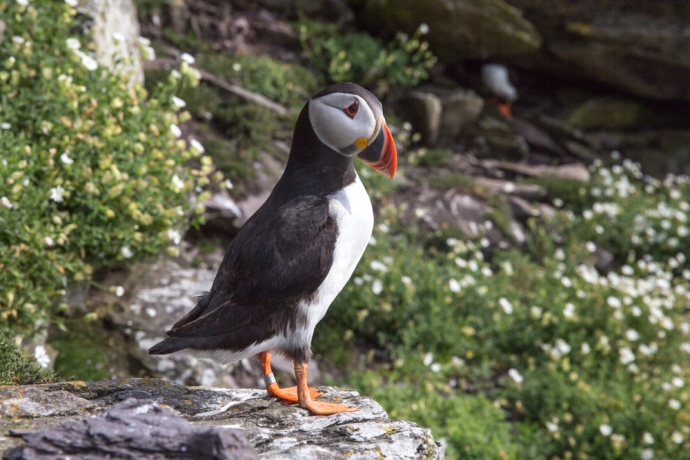
Poser.

Close Encounters of the Bird Kind.
But I am going to pass on the puffins for the moment. I will have more to say about them in another place. It’s not just puffins though. They share the rocks and crevices with many others. Guillemots clustered together with a similar upright stance on the narrowest of ledges, looking for all the world like penguins. Kittiwakes with specially designed claws that enable them to cling on to their precarious piece of rock. Razorbills with their distinctive white streaks to the eyes. Gulls, terns and others such as shearwaters that I didn’t see. An aquatic avian paradise.

Guillemots and kittiwakes nesting on the cliff

Kittiwakes grab their spot wherever they can

Razorbills
The main purpose of any visit to this place though is to see the monastery. Not tackling the 611 steps to the stone structures atop the northern peak would be like visiting the Guinness factory and not having a pint. The journey up is spectacular but so is the reward.

Visitors start the climb

In the footsteps of the monks

The final leg heads up from Christ’s Saddle, the area between the two peaks
It is considered the best example of an early monastery in Ireland and is of world significance. Developed between the sixth and eighth centuries it is truly remarkable for its preservation. A series of terraces contains six ‘clochán’-type beehive cells, two oratories, stone crosses, slabs and a later medieval church. The cells and oratories are all of dry-built corbel construction. This unique method of overlapping stones giving an igloo shape to the outer wall but more regularly rectangular inside is very efficient at keeping out wind and water and have been doing so for 1,500 years. Other terraces housed gardens. Vegetables were believed to have been grown but their main source of food was fish, birds and eggs. The monks led a simple life of foraging and prayer and sought out remote places such as this, as the hardship and sacrifice proved their devotion, until the island was abandoned in the 12th or 13th century.
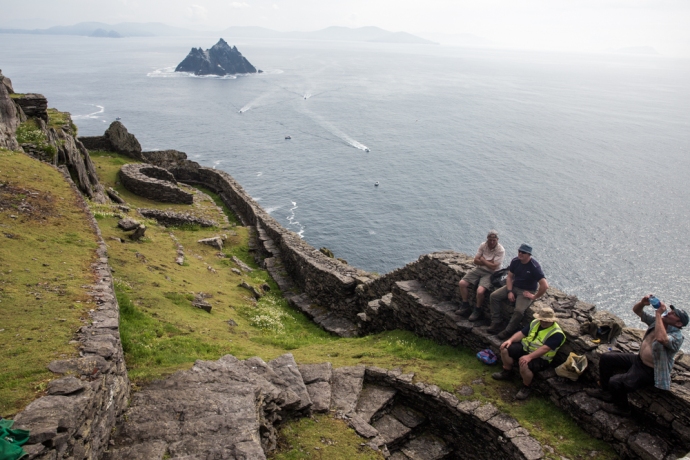

Rich archaeological heritage including beehive huts and a high cross
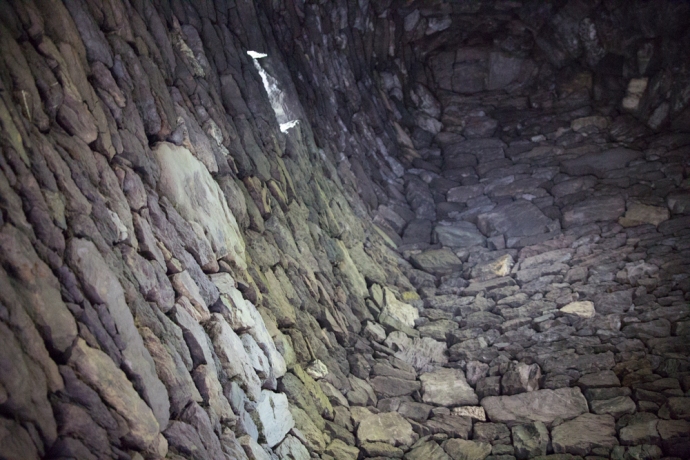
Inside a beehive hut

View through the window of the church
While regaining our breath, one of the OPW guides Catherine, who has been doing this for 18 years gave us the benefit of her wisdom. And cheerfully took my photo as I and countless others posed for the de rigeur ‘selfie’ shot with Little Skellig in the background. Funny how small Ireland is. I had met Catherine at a music festival, two years ago.
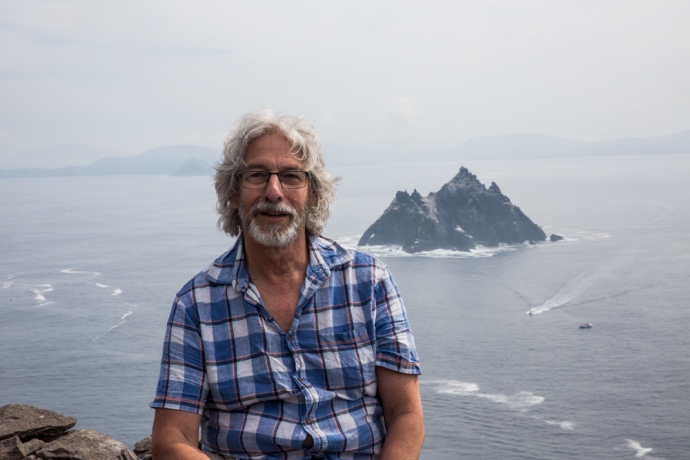
Proof I was there
For some monks sharing this isolation with other monks was still not enough. On the higher south peak there is an hermitage, where a monk is believed to have led a solitary life. You can’t reach it now but just getting there involve huge risk and athleticism, No steps in places just toe holds cut into the rock face. And squeezing through the notorious Eye of the Needle. In the accompanying photo you can just see the terraces across the valley near the very top of the South Peak.

The South Peak. You can just see the stone walls of the Hermitage near the peak.

A close up of the terraces at the Hermitage site.
I can but wonder at the devotion and sacrifice of these people. Their zeal to be closer to God seemed almost to have given them super powers.
Our time at the top though was all too short. Conscious all the time of getting back to the boat I returned down the mountain gingerly negotiating the steps to the bottom. Just a little quicker I have to say than the way up. I surprised myself actually at how doable the climb was and though I saw many struggling I saw no one give up.

The southern shore of the island. One lighthouse is visible on the right
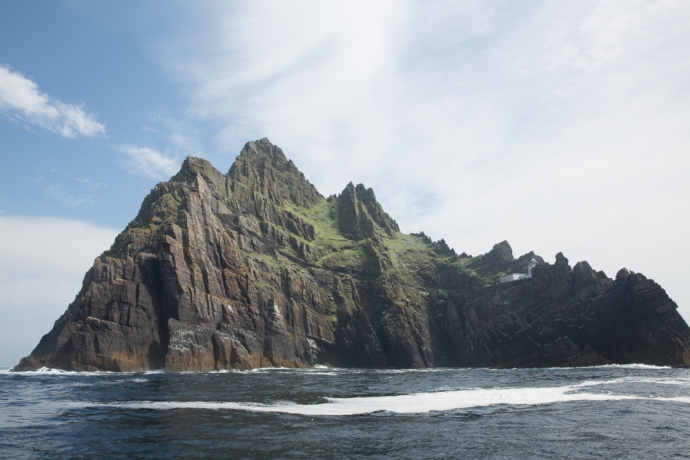
view of the south peak and the road to the second lighthouse

The main landing spot for the monks with the ancient steps up the valley
You can’t get everywhere on the island though. The road to the lighthouses (there are two of them) is closed and they can only be seen from the ocean. In fact on the way home our helpful skipper from Casey’s took us around the southern shore where aside from the lighthouse you can see the other landing points I mentioned.
I met Christina, a fellow Aussie, who was lucky enough to get onto the boat during her short visit to Ireland. It was impossible not to be infected by simply being on this ‘impossible rock’. The joy on her face was real as it was on the faces of the others that were privileged enough to get there on such a warm sunny day.
This will be a lifelong treasured memory for us all.



Absolutely awesome photos, and finally we get to see a photo of yourself. You have aged well. Grey is definitely your color. It must be fun seeing that much of Ireland and doing what you love. Cheers from Australia, Robert, and keep well.
Ha thanks Lyn. I rarely put shots of myself up. For obvious reasons. Hope life is treating you well back in Oz.
Beautiful shots Bob, and what an amazing experience! We must try to make the trip when we return to Ireland.
Thanks. Well worth the effort to get there.
Pingback: You gotta love puffins. | Singersong Blog
Very cool, loved the story and pics